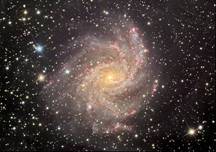 |
| Mars by Etienne Trouvelot 1877 |
In 2003 Mars was closer to us that it had been for over 60,000 years. For our public viewing we opened at dusk and lines formed at the two telescopes - out the door and down the block. The final person viewed Mars at 4:30 AM.
Every 26 months Mars reaches its closest point to the Earth and the
Martian-loving public whips into a frenzy to take a closer look through our
telescopes. We lovingly call this
Marsapalooza.
Check with your local
observatory, planetarium, science center, or astronomy club to see what events
they have scheduled. At the beginning of
the April Mars will appear bright and orange in the eastern sky a little after
sunset. In the middle of the month, Mars
is technically closest to us, but you’ll continue to see it every night until
the end of the year. Each day, the Earth
will pull a little farther away from it until the next closest approach in May
2016.
Tax Day Lunar Eclipse
 |
| Total Lunar Eclipse |
You will have to get up early or stay up late to watch this
eclipse. The show begins at about 2 AM
Eastern Daylight Time (EDT) when you will start to see the rounded shadow of
the Earth appear on the disc of the full moon.
Then over the course of an hour, the shadow will cover more and more of
the Moon’s surface until the moment when the Moon will be completely in the
shadow of the Earth. This is called
totality and it will occur on April 15 from 3:06-4:25 AM EDT.
During totality the Moon will not disappear but instead turn
a different shade. Astronomers cannot
predict what color it will be – pale gray, bright orange, or blood red. Only the shadow knows! Some sunlight will still
reach the surface of the Moon. It bends
through the Earth’s atmosphere and still dimly gives the Moon some unique mood
lighting. Whatever the color, when you see
the total lunar eclipse you are actually seeing all of the sunsets and sunrises
of Earth projected onto the Moon.
After totality ends, you can watch the Earth’s shadow slowly
wipe away from the Moon. The full moon
will appear to be its normal bright self again at around 5:30 AM.











